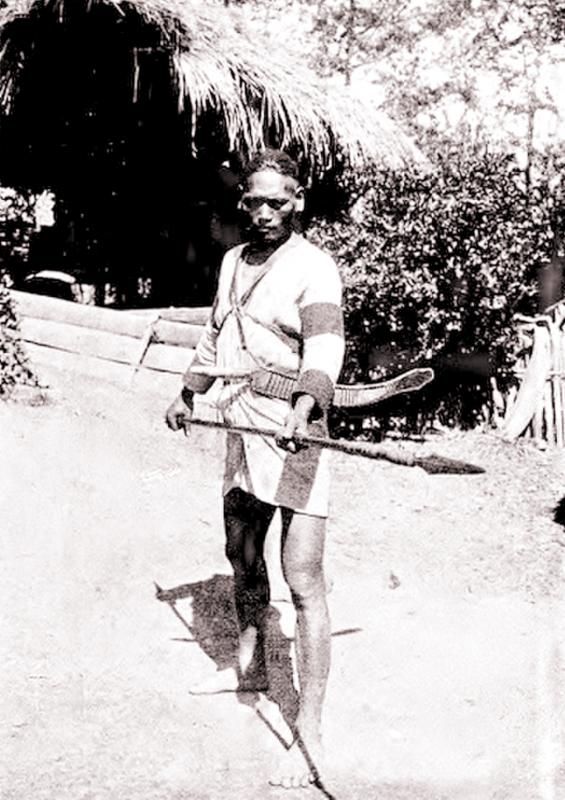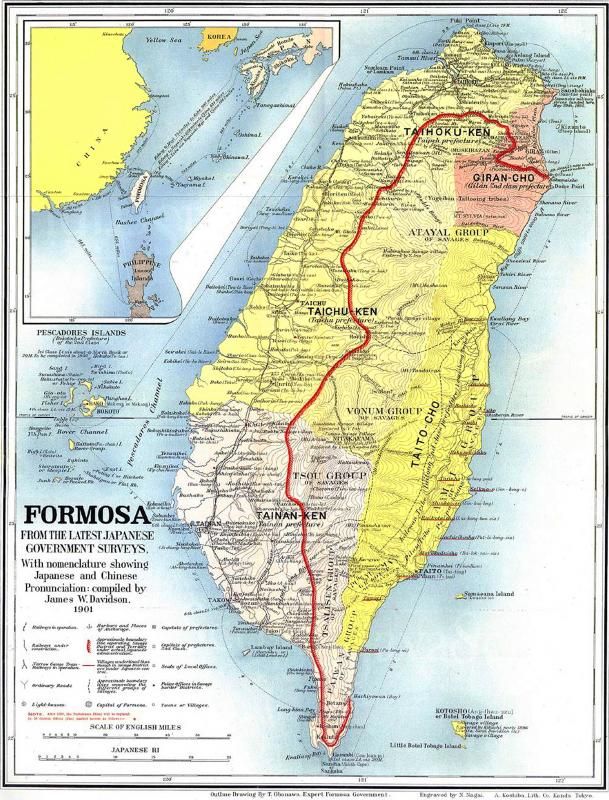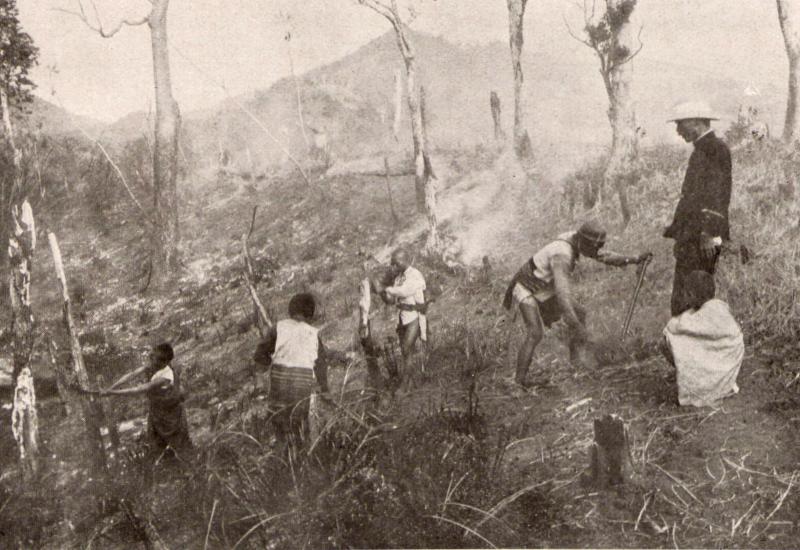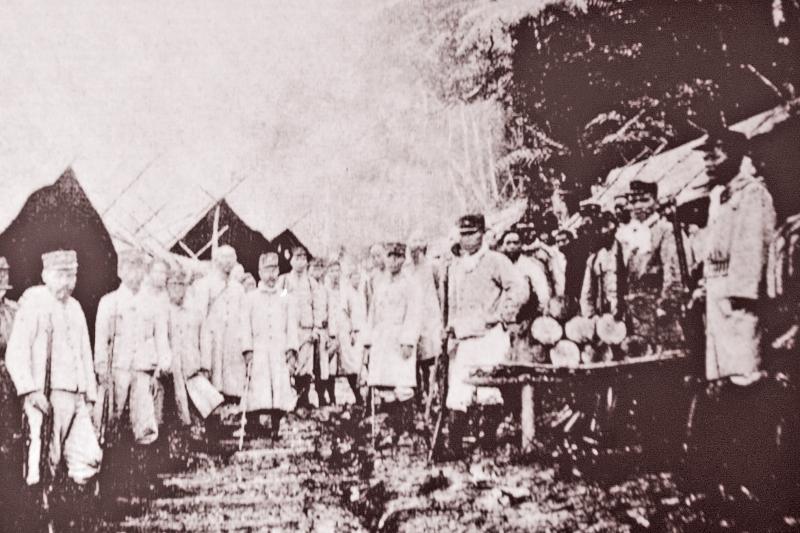May 3 to May 9
The Japanese soldiers thought they had already subjugated the Atayal when they set out toward the mountains of today’s eastern Taoyuan on May 5, 1907. The two brigades, one from the north and one from the south, were tasked with pushing the colonial government’s frontier defense lines deeper into Aboriginal territory to gain access to valuable camphor.
“The defense lines were used to protect the economic activities, mainly camphor production, on the [Japanese] side of the line,” writes Wu Cheng-hsien (吳政憲) in the paper, “The Principle and Utilization of the Mortars on the Frontier Defense Lines” (近代臺灣隘勇線臼砲之原理與應用). “When the government needed to increase their camphor production, they would repeatedly move the frontier defense line further into the mountains.”

Photo courtesy of Wikimedia Commons
The Atayal refused to accept these actions. They thought the boundaries had been set when they acknowledged Japanese rule a year earlier. One group ambushed the northern brigade in the south of today’s Sindian District (新店) in New Taipei City, but was quickly defeated. The new border cut through their traditional hunting grounds, and the community lost its land and its ability to resist.
The southern brigade had a much harder time, as they faced a coalition of various Atayal groups and Han Taiwanese rebels. The group with the most at stake was the Bngciq, who had suffered greatly in a prolonged conflict with the Japanese. If the colonizers got their way, the entire Bngciq territory would end up on the government-controlled side of the frontier, putting the other groups under direct threat.
Thus began the Battle of Zhentoushan (枕頭山戰役), a bloody conflict that began on May 5, 1907 and lasted 107 days and required the Japanese to call thousands of reinforcements from central Taiwan to suppress. In the end, Bngciq chief Watan Syat sued for peace, and the Japanese successfully pushed the frontier line deeper by 11km and 15km, making the area one of Taiwan’s most important camphor production zones.

Photo courtesy of Wikimedia Commons
DECADES OF RESISTANCE
The Mkgogan and Msbtunux Atayal (which included the Bngciq) in the area had been resisting colonial forces for two decades by the time of the battle. In 1886, Qing governor Liu Ming-chuan (劉銘傳) attacked the Atayal to protect Han interests in the mountains (and the government’s camphor trade), launching a conflict that would lead to gradual encroachment on Aboriginal territory.
Fighting in the mountains continued for the next five years until the Mkgogan and Msbtunux banded together to resist the Qing in September 1891. This battle lasted for seven months with severe losses on both sides. Although the Atayal eventually lost, their fierce resistance, coupled with increasing numbers of headhunting incidents along the frontier, finally led the Qing to stop their eastward expansion.

Photo courtesy of National Taiwan Library
After the Japanese gained control of Taiwan in 1895, they visited the area, declared the change of government and invited several villagers to visit the governor-general’s office in Taipei. Relations were cordial at first, but conflicts arose again after the government established the Taiwan Camphor Bureau in 1899.
Shizue Fujii writes in the book, The Msbutunux Incident that the Japanese treated the camphor forests as “unclaimed” land, and allowed any licensed Japanese producer to enter without Atayal permission. In 1900, the frontier defense lines were reestablished with armed police following a sharp increase in Atayal attacks.
Under the leadership of Watan Syat, the Bngciq and other groups in June 1900 expelled the Han camphor producers from the mountains and burned the facilities as well as the camphor bureau office. They fended off Japanese retaliation and were able to enjoy a few more years of relative peace.

Photo courtesy of Wikimedia Commons
However, the Japanese never stopped encroaching on Aboriginal land, pushing the frontier defense line eastward bit by bit and knocking off the Bngciq’s neighboring allies. They came into direct conflict with the Bngciq again in 1904, soundly defeating them in 1906 and forcing them to leave their ancestral land. This scared other Msbtunux groups into surrendering, and camphor production resumed.
FINAL DEFEAT
In March 1907, the government signed a peace agreement with the Atayal. But two months later, they launched an expedition to push back the frontier, igniting the Battle of Zhentoushan. It took the Japanese 41 days to fight their way up the mountain, but reinforcements soon arrived, allowing them to overwhelm the Atayal. The two sides announced a ceasefire on June 23, and met on July 9 to sign a peace agreement. Fujii writes that this is the only existing record of negotiations between the Atayal and Japanese.
The Japanese obtained permission to extend the frontier to Chatianshan (插天山), but agreed to let the village chiefs guide the troops and decide where exactly the line would be. Watan Syat submitted 11 requests, mostly to protect the villagers’ property, interests and safety as well as secure monetary compensation. The Atayal chiefs swore to give up headhunting, and the new frontier defense line was finished on Aug. 20.
The camphor business boomed, but the Atayal soon realized that the Japanese had no intention of keeping their promises. Attacks on the camphor producers resumed until all-out war broke out again in October 1907. This time, the Atayal were crushed within a month, and Watan Syat surrendered to the authorities.
The Taiwan Daily News (台灣日日新報) ran an article, “The regret of the rebel chief,” claiming that Watan Syat was used by Han rebels who wanted to deal a blow to the Japanese without lifting a finger.
“The man who was known for his fierceness finally shed tears and announced his deep regret for his actions,” the report stated.
However, many rebels fled to the other side of the defense line and continued to attack the border guards, and the Japanese responded by cutting off their access to essential goods and bombing their fields during harvest time. Growing desperate with the winter coming, the remaining Msbtunux Atayal crossed the line on Nov. 4, 1908, gave up their guns and swore to “absolutely obey official orders.”
In February 1910, governor-general Samata Sakuma personally visited the frontier to assert Japanese authority. A month later, he brought visiting British diplomats to the area on a boar hunting trip to flaunt the colonial government’s success in “pacifying the savage lands.”
With many hostile Aborigines remaining across Taiwan, Sakuma launched his second five-year plan to “govern the savages” that same year. His forces immediately ran into resistance from the Mkgogan Atayal, who declared war on the Japanese in June. The Japanese expected to finish them off within two months, but the Atayal resisted until Nov. 19, when the last group surrendered their firearms.
Taiwan in Time, a column about Taiwan’s history that is published every Sunday, spotlights important or interesting events around the nation that either have anniversaries this week or are tied to current events.

Exceptions to the rule are sometimes revealing. For a brief few years, there was an emerging ideological split between the Democratic Progressive Party (DPP) and Chinese Nationalist Party (KMT) that appeared to be pushing the DPP in a direction that would be considered more liberal, and the KMT more conservative. In the previous column, “The KMT-DPP’s bureaucrat-led developmental state” (Dec. 11, page 12), we examined how Taiwan’s democratic system developed, and how both the two main parties largely accepted a similar consensus on how Taiwan should be run domestically and did not split along the left-right lines more familiar in

As I finally slid into the warm embrace of the hot, clifftop pool, it was a serene moment of reflection. The sound of the river reflected off the cave walls, the white of our camping lights reflected off the dark, shimmering surface of the water, and I reflected on how fortunate I was to be here. After all, the beautiful walk through narrow canyons that had brought us here had been inaccessible for five years — and will be again soon. The day had started at the Huisun Forest Area (惠蓀林場), at the end of Nantou County Route 80, north and east

Specialty sandwiches loaded with the contents of an entire charcuterie board, overflowing with sauces, creams and all manner of creative add-ons, is perhaps one of the biggest global food trends of this year. From London to New York, lines form down the block for mortadella, burrata, pistachio and more stuffed between slices of fresh sourdough, rye or focaccia. To try the trend in Taipei, Munchies Mafia is for sure the spot — could this be the best sandwich in town? Carlos from Spain and Sergio from Mexico opened this spot just seven months ago. The two met working in the

This month the government ordered a one-year block of Xiaohongshu (小紅書) or Rednote, a Chinese social media platform with more than 3 million users in Taiwan. The government pointed to widespread fraud activity on the platform, along with cybersecurity failures. Officials said that they had reached out to the company and asked it to change. However, they received no response. The pro-China parties, the Chinese Nationalist Party (KMT) and Taiwan People’s Party (TPP), immediately swung into action, denouncing the ban as an attack on free speech. This “free speech” claim was then echoed by the People’s Republic of China (PRC),